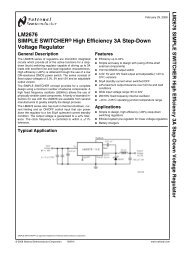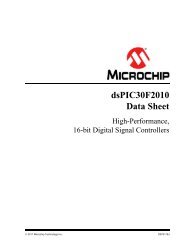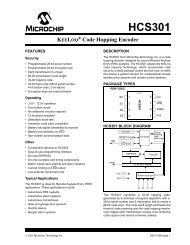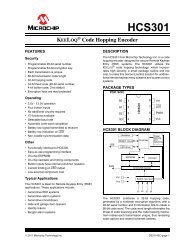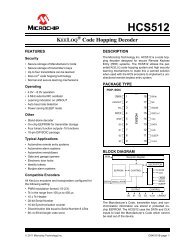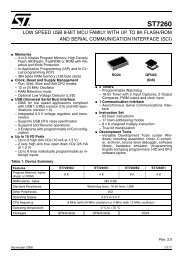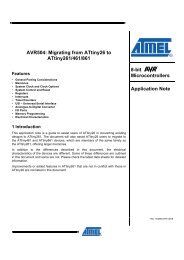Create successful ePaper yourself
Turn your PDF publications into a flip-book with our unique Google optimized e-Paper software.
<strong>STM32W108C8</strong><br />
System modules<br />
Bit 1 SLEEPTMR_CLK10KEN: Enables 10kHz internal RC during deep<br />
Note: Bits are cleared when set to ‘1’.<br />
Bit 0 SLEEPTMR_CLK32KEN: Enables 32kHz external XTAL<br />
Note: Bits are cleared when set to ‘1’.<br />
6.5 Power management<br />
The <strong>STM32W108C8</strong>'s power management system is designed to achieve the lowest deep<br />
sleep current consumption possible while still providing flexible wakeup sources, timer<br />
activity, and debugger operation. The <strong>STM32W108C8</strong> has four main sleep modes:<br />
● Idle Sleep: Puts the CPU into an idle state where execution is suspended until any<br />
interrupt occurs. All power domains remain fully powered and nothing is reset.<br />
●<br />
●<br />
●<br />
6.5.1 Wake sources<br />
Deep Sleep 1: The primary deep sleep state. In this state, the core power domain is<br />
fully powered down and the sleep timer is active<br />
Deep Sleep 2: The same as Deep Sleep 1 except that the sleep timer is inactive to<br />
save power. In this mode the sleep timer cannot wakeup the <strong>STM32W108C8</strong>.<br />
Deep Sleep 0 (also known as Emulated Deep Sleep): The chip emulates a true deep<br />
sleep without powering down the core domain. Instead, the core domain remains<br />
powered and all peripherals except the system debug components (ITM, DWT, FPB,<br />
NVIC) are held in reset. The purpose of this sleep state is to allow <strong>STM32W108C8</strong><br />
software to perform a deep sleep cycle while maintaining debug configuration such as<br />
breakpoints.<br />
When in deep sleep the <strong>STM32W108C8</strong> can be returned to the running state in a number of<br />
ways, and the wake sources are split depending on deep sleep 1 or deep sleep 2.<br />
The following wake sources are available in both deep sleep 1 and 2.<br />
● Wake on GPIO activity: Wake due to change of state on any GPIO.<br />
● Wake on serial controller 1: Wake due to a change of state on GPIO Pin PB2.<br />
● Wake on serial controller 2: Wake due to a change of state on GPIO Pin PA2.<br />
● Wake on IRQD: Wake due to a change of state on IRQD. Since IRQD can be<br />
configured to point to any GPIO, this wake source is another means of waking on any<br />
GPIO activity.<br />
● Wake on setting of CDBGPWRUPREQ: Wake due to setting the CDBGPWRUPREQ bit<br />
in the debug port in the SWJ.<br />
● Wake on setting of CSYSPWRUPREQ: Wake due to setting the CSYSPWRUPREQ bit<br />
in the debug port in the SWJ.<br />
The following sources are only available in deep sleep 1 since the sleep timer is not active in<br />
deep sleep 2.<br />
● Wake on sleep timer compare A.<br />
● Wake on sleep timer compare B.<br />
● Wake on sleep timer wrap.<br />
Doc ID 018587 Rev 2 48/215





